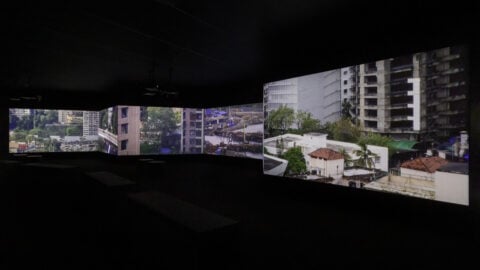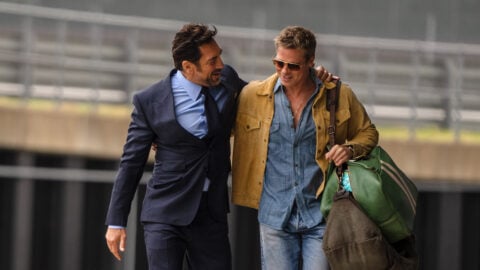Review: The Hobbit: An Unexpected Journey

The Hobbit: An Unexpected Journey is a movie of firsts, if not especially auspicious ones. It is the only production to spread out a 300-page novel over three films that will total close to nine hours, necessitating a Part One script choked with exposition. Then there is the debut of the controversial 48 frames-per-second format in which director Peter Jackson shot the movie, which doubles the amount of information that normally passes before a viewer’s eyes. Only 450 theaters (out of approximately 4,000) will screen the feature at 48fps, though, in what Warner Bros. has called “HFR (high frame rate) 3D,” following a disastrous preview at CinemaCon earlier this year. The vast majority of audiences will watch The Hobbit in traditional 24fps, but seeing it in HFR is a singularly alienating and fascinating experience. The level of detail is so intense that eyeing the tufts of felt in Gandalf’s wizard hat becomes far more dramatic than anything else that transpires in this drawn-out rendition of the first six chapters of J.R.R. Tolkien’s novel.
The movie exactingly recounts the young adventures of Bilbo Baggins as he is drawn into a Dwarvish quest to wrest their ancestral kingdom back from the dreaded dragon Smaug after decades in exile. Old Bilbo (Ian Holm) recalls the story in flashback, with Martin Freeman taking the diminutive reins as his younger self. While Jackson and his collaborators ably condensed the three Lord of the Rings novels into stand-alone features, here they are tasked with stretching out the material to absurd lengths, which is apparently why the Dwarf dinner in the Shire seems to take place in real time, from table setting to dishwashing.

The trek toward the Dwarves’ ancestral Lonely Mountain is a stop-start affair. As Jackson intersperses helicopter shots with lumbering backstory filler, and the story is obsessively elaborated upon, the characters disappear into the New Zealand landscape. The Dwarves are interchangeable, aside from the generic stoicism of their leader Thorin (Richard Armitage), and Freeman is given little to do beyond hover neurotically like a Hobbit Woody Allen. The only fully embodied presence is, ironically, the motion-captured performance of Andy Serkis as Gollum, the schizo ring-addict who can shift from psychotic abuser to meek victim with the delicate enlargement of his teary eyes.
The tempo picks up in the final third as theme-park-ride action sequences take over, like the wooden rollercoaster ride through Goblin hordes that morphs into a mountainside Orc battle. These provide adrenaline spikes, although they are the kind of tumbling CGI chases better executed in video games, which are often in 60fps, no less. Something like Uncharted on the PS3 produces the same feeling of velocity, but in unbroken takes and with a greater sense of control. What Peter Jackson hopes will distinguish The Hobbit, and cinema in general, is the addition of 48fps to 3D, which eliminates the motion blur that causes headaches in 24fps. But while solving that one issue, the change also completely alters the texture and feel of the filmic image.

In comparison to 24fps, HFR looks over-bright and queasily clear, with figures sharply separated from their backgrounds. The seams between CGI figures and natural landscapes become glaringly obvious, the kind of thing flawed, hazier 24fps hides more easily. HFR has none of the mystery of regular 24fps: every pore and stitch is revealed to the eye. Many reactions to the HFR screenings have cited how much it looks like old soap operas or British television. That makes sense, since the difference between 24 and 48fps is a comparable leap from watching the 525 lines of resolution on U.S. NTSC tube TVs to the PAL European television standard of 625. As we got used to watching Fawlty Towers, maybe the same will hold true for HFR, but it just seems unsustainable for an entire feature. In many shots, especially in the brightly lit interiors of the Shire, I stopped paying attention to the story and fixated on the detail in the wainscoting or the aforementioned fluff in Gandalf’s hat. Things look so real that it’s impossible to suspend disbelief, since it’s obvious the actors are putting on a show, the filmmaking apparatus making itself visible through the hyperreal clarity.
The increased frame rate plays well during the movie’s all-CGI action scenes, when neither motion blur nor any burden of dramatic realism destroys the illusion. That suggests the format might be best suited for selective use. In fact, special-effects wizard Douglas Trumbull, who has been experimenting with higher frame rates since the 1970s with his ShowScan technology, recently proposed just such a partial implementation of HFR. He has applied for a patent on a system in which you could ramp up or down the frame rate depending on the sequence: for dialogue-heavy interiors you could use the familiar filmic 24fps, but for fantastical action use 48.

It will be interesting to see how Jackson proceeds in the two sequels, and likewise James Cameron in the next two Avatars (which he might shoot in 60fps). Whatever their decision, so will go the industry. The advocacy of Jackson, Cameron, and George Lucas spurred the shift to digital projection, forced the re-emergence of 3D, and now has introduced HFR (even though studios rarely give directors aside from these three the freedom to experiment fully with the tech).
The Hobbit is an awkward first step in the use of higher frame rates, a big-budgeted test reel that theaters are not even charging extra for. The next wave in movie theater upselling might be provided by Trumbull. He’s working on a new process that involves shooting in 120fps and projecting the resulting movie on a “deeply curved hemispheric screen” (“If it’s successful, the audience will actually be in the movie—not looking at the movie”). Reminiscent of the 1950s curved-screen Cinerama process, Trumbull’s grand idea proves that everything old in Hollywood is forgotten and made new again.







